There are many frameworks with react ui libraries used for completely different purposes. They help developers understand all the code’s intricacies and the features of interfaces designed faster. They save time and effort during intense product design projects. This article will focus on the best react ui framework and react styling libraries for building your ReactJS projects.

What is React UI Component Library?
A tool or software system containing ready-to-use components for use in React-based applications and sites is known as a React UI component library. These component libraries assist speed up software development while providing a wealth of advantages to programmers and enterprises.
In UI context, a component library is a collection of user interface (UI) elements, such as button designs, font choices, and other typography and visual components. Such a react ui library’s goal is to collect reusable user interface elements in one location for later use in other projects to optimise the process.
Thus, a software system or toolchain that includes a collection of components—design elements that are prepared for usage in React applications—is known as a React UI library or React component library.
When to use a React UI library?
React is a popular library in web development even though it isn’t a language. You may use it every time you need develop a great web application and in other React best practices simply because it has a range of benefits.
Thus, utilizing a React UI component library has the following benefits:
- Accelerated development
- You can use a React UI component library like MUI, Chakra UI, React Bootstrap, etc. rather than writing the code for each component individually.
- They will introduce you to a variety of readily usable components that are appropriate for your design.
Besides, you may use it for UX. Both UI and UX use React. React’s emphasis on the view layer enables it to be used for both static and dynamic UIs, and its composability and responsiveness make it a good choice for developing responsive and reactive user interfaces.
Top 14 React frameworks and component libraries in 2023
Let’s check out some React frameworks to pick the best react ui library and create the best product with great functionality and appearance.
1. Material Kit React
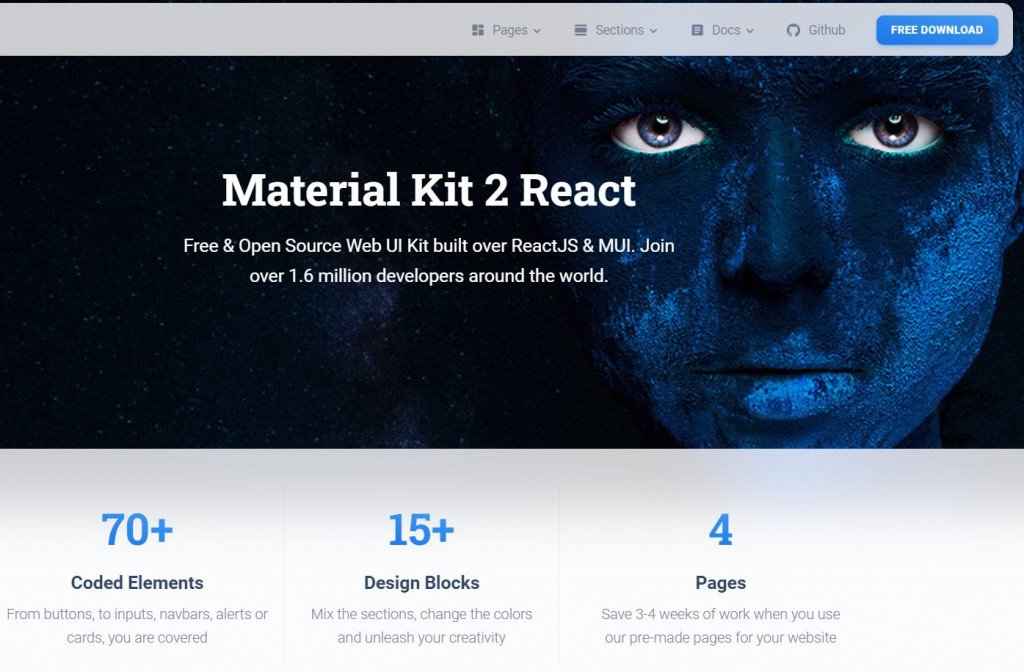
The most recent free MUI Design System built on React is called Material Kit 2 React. With pre-built design blocks included in this free MUI & React template, the development process is straightforward, making it simple to transition from our pages to the live website.
Its stunning design draws inspiration from Material Design and includes all the elements required for creation. It is your match if you’re a developer looking to build attractive, feature-rich, and fully customizable websites.
Pros:
- Access to the theme values from the component props is granted
- Open source, lightning-fast, and excellent
- Developer-first product with a strong community that is less than KB gzipped
- enables a number of variables
- Consistently good user interface design with an easy-to-use layout
- respects MIT license rules for coding
The Kit also offers a number of fundamental components, like sliders and buttons, badges, pagination, navigation bars, menus, pills, and tabs. The style, size, and color of the majority of elements may all be changed with the aid of this React component package.
Additionally, the Material Kit React Pro version includes a number of additional elements, sections, and sample pages.
Installation:
From the NodeJs official page, download and install the LTS version of NodeJs.
Install our local dependencies by running yarn install or npm install from the product’s root./ directory.
npm i material-kit-react
The documentation for the Material Kit React is hosted here website.
2. React Router
A well-liked little library for React is React Router. It enables the creation of single-page apps with client-side, dynamic routing. React Router enables developers to declaratively specify the routes of their applications using JSX and is built to function in unison with React. As a result, building intricate, hierarchical navigational structures within a single-page application is simple.
Pros:
React Router also has the advantage of supporting browser history management, allowing users to navigate the application using the browser’s back and forward buttons.
- It renders a small piece of a big data collection using windowing.
- offers adaptable API
- allows for responsive design
- It can only render things that are on the screen thanks to virtualization.
The ability to do code splitting, which enables developers to load only the components required for a given route, reduces the initial loading time of the application and improves performance, is one of the main advantages of utilizing React Router.
Installation
npm create vite@latest name-of-your-project — –template react
# follow prompts
cd <your new project directory>
npm install react-router-dom localforage match-sorter sort-by
npm run dev
Full React Router Tutorial here.
3. Blueprint UI
Blueprint UI is yet another well-liked entry on this list of the top React frameworks. This well-known React framework for the front-end creation of computer applications is built on CSS.
The design of user interfaces for intricate and data-intensive web pages is best suited for Blueprint UI. A CSS collection of 30 components, with choices for little scripting and coding, is available in Blueprint UI.
Pros:
The multi-touch interface offered by Blueprint UI is user-friendly, intuitive, and excellent for quickly creating websites and applications. The fundamental components of this React framework additionally have separate components for selection, date/time, tables, icons, and other things. Blueprint UI features adjustable design components including classes, typography, and color scheme as well as dark and light theme settings.
Installation:
First, ensure you have nvm (Node Version Manager) installed. After cloning this repo, run to One-time setup:
- In order to develop Blueprints, nvm uses the supported Node version.
- yarn to set up the monorepo’s dependencies completely.
- npm install -g windows-build-tools will install build tools globally if you’re using Windows.
- Run npm config set script-shell “C:Program Filesgitbinbash.exe” yarn verify to confirm that bash is the script-shell you have defined. This will guarantee that all of the build tools are operating as they should.
Usage:
yarn add @blueprintjs/core react react-dom
It is applied to provide a fluid user experience and offers thorough and simple to understand documentation.
Import React components from the appropriate package.
import { Button } from “@blueprintjs/core”;
<Button intent=“success” text=“button content” onClick={incrementCounter} />
4. Material UI
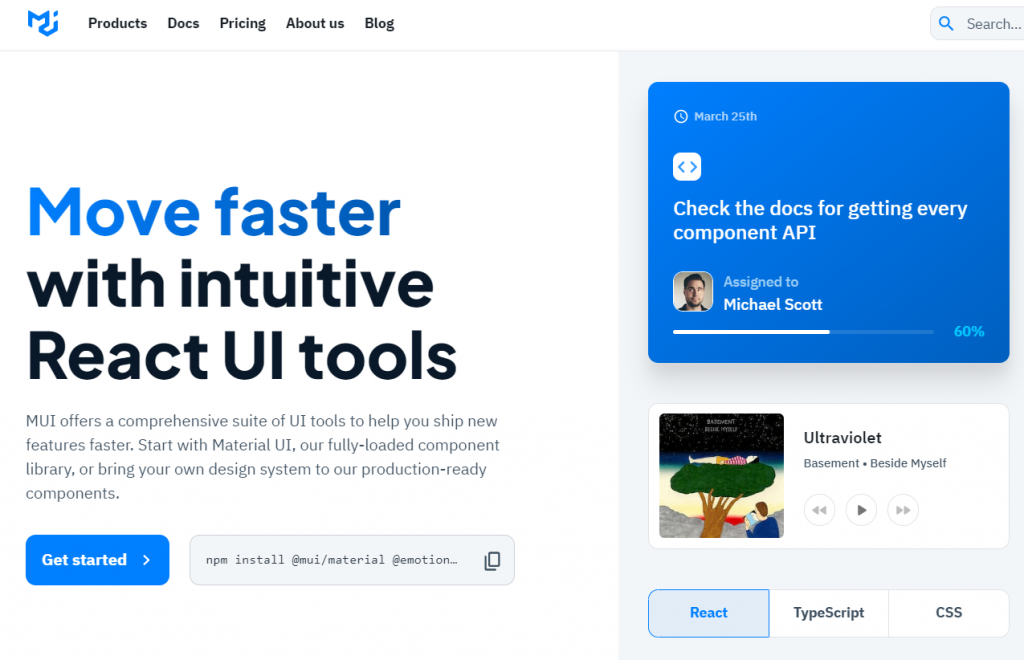
For aiding in the creation of native mobile apps, the Material UI provides a wide range of tools and APIs. MUI offers automated color changes and compatibility across CSS-based modules and style components.
According to the manufacturers, Material UI provides the developer with components for fast and easy web development. To assist you in releasing new features more quickly, MUI offers an entire suite of UI tools.
MUI is the framework of choice for a large and active community of front-end developers. The framework helps programmers handle the documentation and allay their anxieties and ambiguities.
Pros:
- reusable and modifiable components
- responsive components and a strong theming system
- a sizable and vibrant development community
With it you may accelerate construction without losing control or flexibility. You will be able to produce features more quickly because to the vast selection of high-quality components that MUI supplies. Additionally, the well-designed customisation system of MUI provides the opportunity to stand out in the industry better.
Instalaltion:
To get started:
npm install @mui/material @emotion/react @emotion/styled
$ npm install @material-ui/core
Usage:
import React from ‘react’;
import { Button } from ‘@material-ui/core’;
function App() {
return <Button color=”primary”>Hello World</Button>;
}
5. React Bootstrap
Bootstrap JavaScript is replaced by React-Bootstrap. Each component was created from the ground up as a genuine React component, free of other dependencies like jQuery.
React Bootstrap is perhaps the most popular frontend framework adapted for ReactJS. The most popular front-end framework Rebuilt for React as per their official website.
Pros:
React-Bootstrap is one of the first React libraries, and because it has developed and matured alongside React, it is a great option for your UI foundation.
Compatibility, or support for both the largest UI ecosystem and the Bootstrap core, is a key component of React Bootstrap CSS. The hundreds of Bootstrap themes used by developers worldwide are very compatible with the framework.
Installation:
$ npm install react-bootstrap bootstrap
import Button from ‘react-bootstrap/Button’;
// or less ideally
import { Button } from ‘react-bootstrap’;
Usage:
import Button from ‘react-bootstrap/Button’;
// or not very correct option
import { Button } from ‘react-bootstrap’;
function App() {
return <Button>Hello World</Button>;
}
Useful docs here:
You can save time by using the React-Bootstrap integration or react bootstrap alternatives because the JavaScript pieces are already present and neatly tied up in React-shaped bows. You should be familiar with JavaScript and JavaScript plug-ins if you choose to use Bootstrap as-is because you’ll have to work with those components independently.
6. Atomize
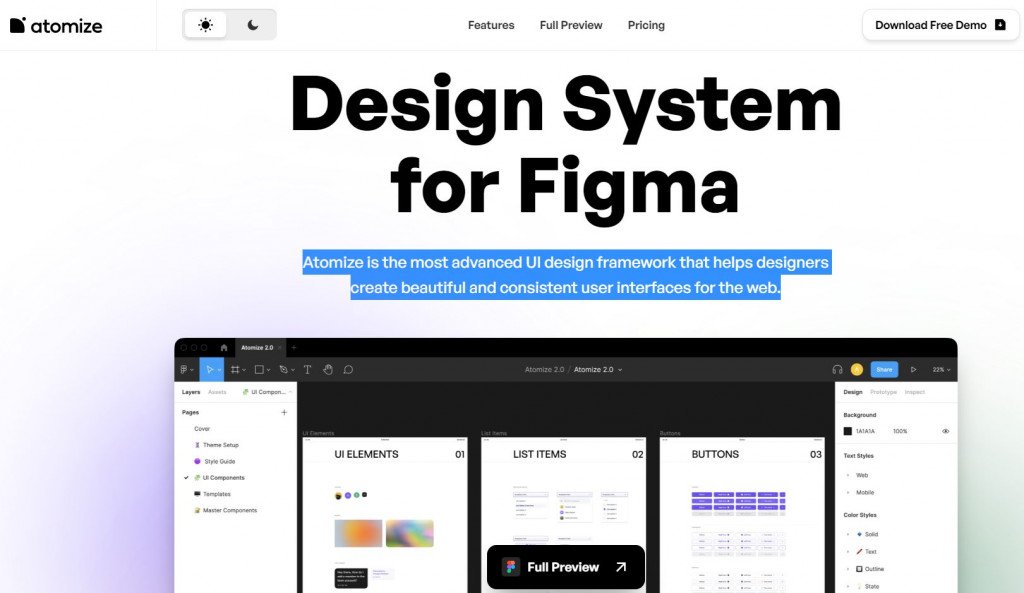
Atomize Design System is the most advanced design environment for beautiful and consistent user interfaces. The most cutting-edge UI design framework, Atomize, aids designers in producing stunning and reliable user interfaces for the web.
Pros:
- It is trusted by 7000+ designers, teams from Blurb, Thoughtworks, Latch, and other organizations.
- helps you quickly set up a bespoke design system and relieve you of all the tedious tasks.
Installation:
$ npm install atomize react-transition-group
Usage:
import { Button } from “atomize”;
function App() {
return <Button>Hello World</Button>;
}
7. Semantic UI
A helpful open-source project on GitHub called Semantic UI is used to create CSS style sheets using the React framework. Enhancement for creating responsive web pages with distinctive component functionalities is provided by the Semantic UI framework.
User interfaces with semantics React is the official React integration used by Semantic UI. The jQuery-based library Semantic UI gives the workflow additional versatility. JSX code is used to create direct elements, which are subsequently bound to the React element’s code. It features a lengthy set of preconfigured components that were made specifically to comprehend and write semantically sound code.
Pros:
- More than 50 UI components
- easier Adaptive debugging
- Easy personalization
Installation:
Semantic UI is available in an eponymous package on NPM. To get started, go here.
8. Ant Design
Ant Design is an efficient and enjoyable enterprise-level user interface design system. Developers frequently utilize Ant Design, a CSS framework for React, to produce visually appealing UI components. Ant Design provides a sizable design library for front-end development, and for client development, a GUI design. The framework’s design components are easy to integrate, and React can use them directly.
Pros:
Ant Design is efficient and enjoyable enterprise-level user interface design system. Themes, design components, and development tools in Ant Design can all be easily customized.
- Support for several languages makes it simpler to create applications for a worldwide audience
- gives access to a developer-friendly API
- In response to the user’s device and screen size, responsive components can dynamically change their size, layout, and appearance.
- provides support for TypeScript
- strong thematic system
More than 50 components make up the Ant Design library, which aids in creating user interfaces for enterprise-level applications. Due to its adaptable design and functionality, more than 100 businesses choose Ant Design for their projects.
Cons:
There were no problems discovered when the npm package antd was checked for known vulnerabilities and a missing license. Thus, it was decided that using the package was safe.
Installation:
$ npm install antd
Usage:
import { DatePicker } from ‘antd’;
ReactDOM.render(<DatePicker />, mountNode);
9. Chakra UI
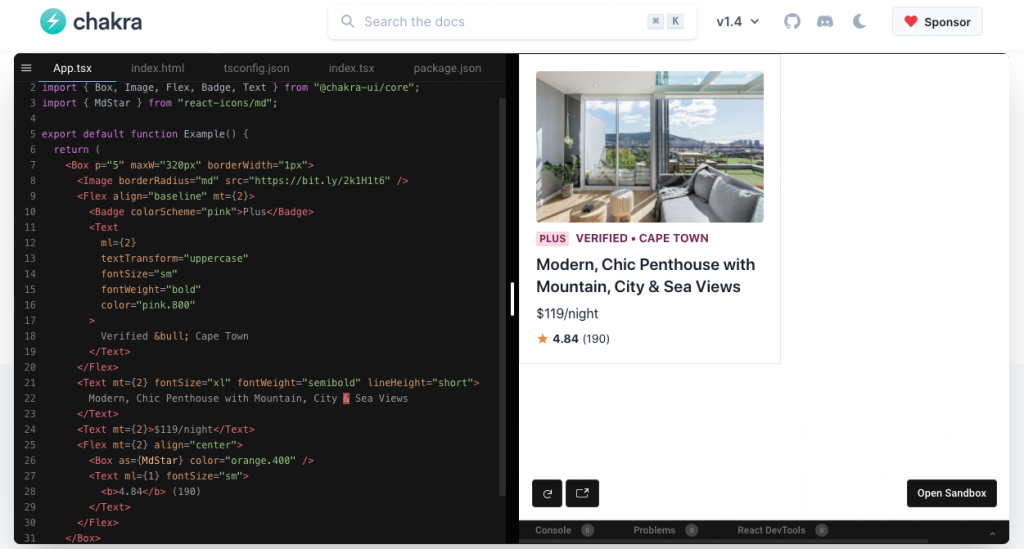
The next React JS framework on our list is Chakra, a library of React components that requires less time to write code. The Chakra UI provides accessible, modular, and adaptable UI components for creating apps, allowing for quicker development.
If you hire react js developers, they may rapidly design newer components thanks to Chakra UI. The components of Chakra UI are reusable, adaptable, and compliant with WAI-ARIA guidelines.
Pros:
Chakra UI is modular, easy-to-collection frontend library.
- It provides access for people with disabilities
- a complete collection of reusable parts
- Support for Light / Dark mode
- employs CSS-in-JS
Cons:
There’s impossible to style some components.
Chakra UI comes with a variety of inputs, accordions, tips, and icons as well as dark and light UI settings, themes, and 49+ components. Despite the Chakra UI library’s short age, the community is engaged in clearing up confusion.
Installation:
npm i @chakra-ui/react @emotion/react@^11 @emotion/styled@^11 framer-motion@^4
Usage
import * as React from “react”
// 1. import `ChakraProvider` component
import { ChakraProvider } from “@chakra-ui/react”
function App() {
// 2. Use at the root of your app
return (
<ChakraProvider>
<App />
</ChakraProvider>
)
}
10. React Redux
React Redux is a dependable component framework and react css library
with an easy-to-use UI and effective code-testing tools. The interface automatically gets, changes, and appraises the data when developers enter it for the components. Redux offers a number of DevTools that may be used to track log updates, identify application state changes, and issue error messages.
Pros:
- has a centralized and predictable state management system
- supports rendering on the server
- enables middleware
- application architecture that is simpler
With over 21,000 GitHub stars, Redux is one of the most used React libraries.
With Angular, React, and many more JavaScript frameworks, Redux integrates flawlessly.
Redux allows developers to write consistent code, connect React code to various components, and edit it as the app is being used.
Installation:
npm install react-redux
11. Grommet
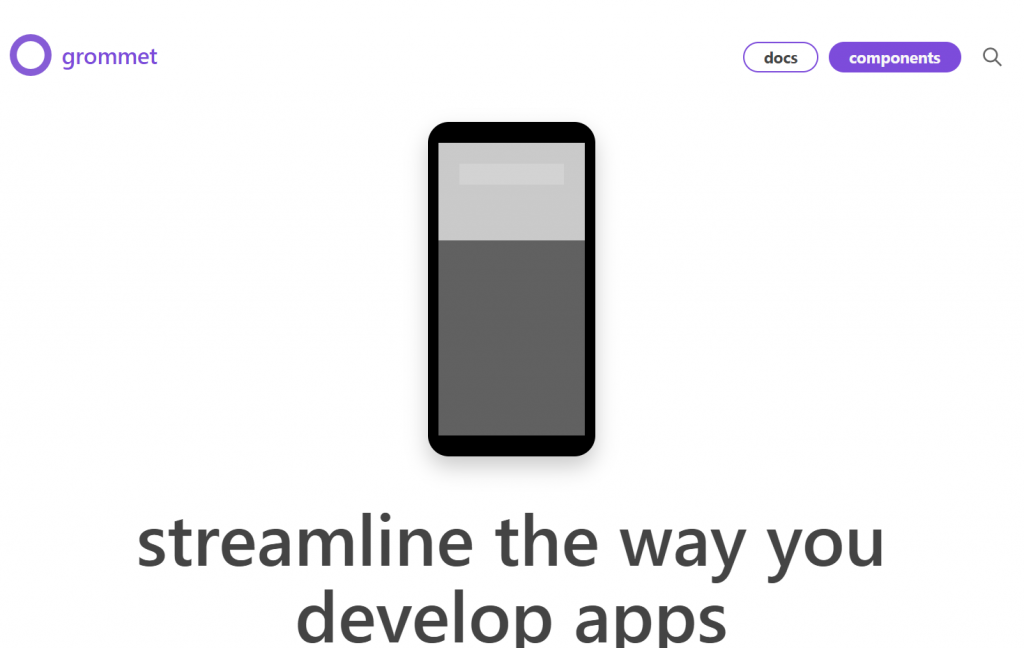
Grommet was created by HPE as a CSS framework for React with component packages for creating fluid and user-friendly mobile webpages. Grommet features a lively and dynamic layout, excellent accessibility, appealing themes, modularity, and simplicity. Grommet can be used to build new projects with sophisticated themes or integrate them into already-existing ones.
In one convenient package, responsiveness, adaptability, and usability. Grommet makes developing adaptable, inclusive, and mobile-first web applications simpler by including an intuitive library area. One of Grommet’s main advantages is its capacity to be seamlessly integrated into both current and upcoming endeavours.
Pros:
- Support for disabled users out of the box (W3C support)
- considerable theming is offered
- Modular and adaptable design
- design-oriented strategy
- offers responsive elements
To help with front-end development, Grommet provides an icon component with a sizable bank of SVG icons. The Grommet library also provides controls, utilities, media options, input visualization, layouts, and color schemes for UI customization.
Installation:
const App = props => (
<Grommet>
<Box align=”center” background=”graph-2″ pad=”medium”>
<Button
label=”hello world”
primary
onClick={() => alert(‘hello, world’)}
/>
</Box>
</Grommet>
);
render(<App />);
12. Storybook
Storybook deserves a special mention on our list of ReactJS frameworks. For a very long time, Storybook has been a favorite among developers. This is not an independent component library. It functions more like an open-source tool for creating standalone UI components for React and a number of other platforms and technologies.
You can record components in Storybook for later usage. Additionally, it enables you to test your components visually for flaws instantly. Not to mention, you can optimize responsive layouts, check accessibility, and do a lot more with the help of an ecosystem of add-ons.
Pros:
- Clean and effective UI;
- Quick UI development;
- Simple and seamless integration with React apps;
- Built-in TypeScript support;
- Default Webpack configuration;
- Efficient development process;
- High compatibility with most front-end frameworks;
- CSS support;
- Hot module reloading;
- Deployment of a whole storybook as a static app;
- Isolated environment for components;
Installation:
npm run storybook
Find Storybook tutorials. Besides, feel free to discover more on Vue vs React.
Benefits of using React UI frameworks
Using React JS has unquestionably many significant advantages. Following are a few advantages of utilizing React UI frameworks:
Rapid and painless development
React UI frameworks offer a collection of simple pre-made, editable components to incorporate into your application, saving you time and effort during development.
Consistent design throughout all components:
React UI frameworks offer a consistent design and user experience throughout all of their components, making it simple to develop a user interface that is both unified and simple to use.
High-quality components
React UI frameworks offer high-quality components, ensuring that your application is dependable and free of errors and problems.
Function flawlessly
React UI frameworks are built to function flawlessly across all contemporary browsers and devices, ensuring that your application runs smoothly for all users. This is known as excellent cross-platform compatibility.
High usability and accessibility
React UI frameworks are created with usability in mind, offering a collection of components that are accessible to people with disabilities.
Strong theming system:
A number of React UI frameworks offer a strong theming system that enables designers to alter the look and feel of its elements to fit the layout of their applications.
Good community support
A sizable and active community of developers supports the React frameworks, ensuring that they are kept abreast of the most recent advancements in React and web development in general.
Conclusion
In general, employing React-based frameworks can assist developers in more quickly creating contemporary, responsive, and accessible web apps with a unified design and high-quality react ui components. As a result, the development process may go faster, users may have a better experience, and the codebase may become more scalable and manageable. Want to try? – Do it with our help any time you have a great product idea to develop.





















